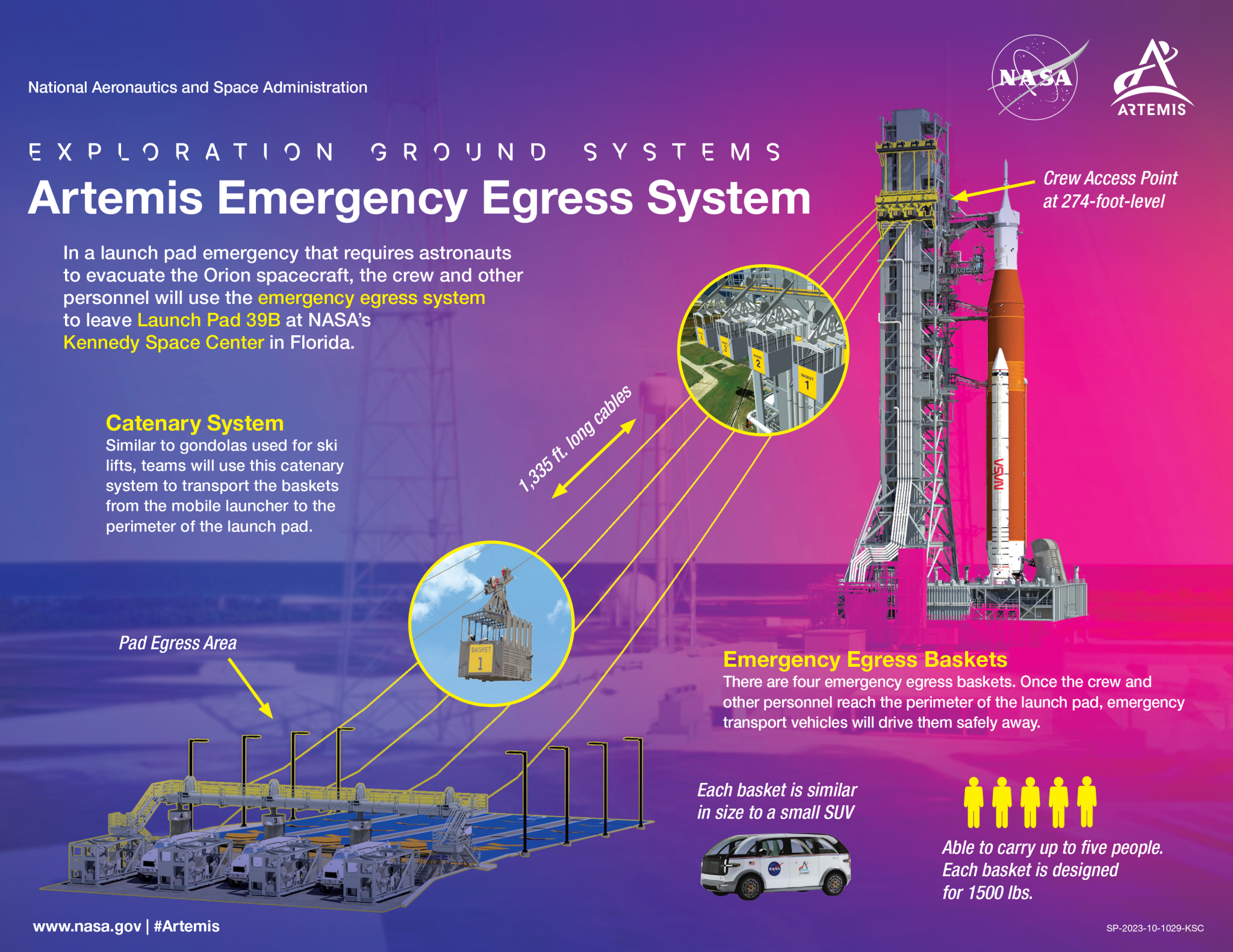Artemis Emergency Egress System Emphasizes Crew Safety
Since NASA began sending astronauts to space, the agency has relied on emergency systems for personnel to safely leave the launch pad and escape the hazard in the unlikely event of an emergency during the launch countdown. During the Mercury and Gemini programs, NASA used launch escape systems on spacecraft for the crew to safely […]

Since NASA began sending astronauts to space, the agency has relied on emergency systems for personnel to safely leave the launch pad and escape the hazard in the unlikely event of an emergency during the launch countdown.
During the Mercury and Gemini programs, NASA used launch escape systems on spacecraft for the crew to safely evacuate if needed. Though these systems are still in use for spacecraft today, the emergency routes on the ground were updated starting with the Apollo missions to account for not only the crew, but all remaining personnel at the launch pad.
During Apollo, personnel relied on a ground-based emergency egress system – or emergency exit route – to allow for a quick and safe departure. Though the system has varied over time and different launch pads use different escape systems, the overall goal has stayed the same – quickly leave the launch pad and head to safety.
Beginning with Artemis II, the Exploration Ground Systems (EGS) Program at Kennedy Space Center in Florida, will use a track cable which connects the mobile launcher to the perimeter area of the launch pad where four baskets, similar to gondolas at ski lifts, can ride down. Once down at the ground level, armored emergency response vehicles are stationed to take personnel safely away from the launch pad to one of the triage site locations at Kennedy.
“We have four baskets that sit on the side of the mobile launcher tower at the same level as the crew access arm, the location where the crew enters the spacecraft,” said Amanda Arrieta, mobile launcher 1 senior element engineer for NASA’s EGS Program. “The intention is to provide another means of egress for the crew and the closeout crew in the event of an emergency. Each of these baskets will go down a wire. It’s a wire rope system that connects to the pad terminus, an area near the pad perimeter where the baskets will land after leaving the mobile launcher tower.”
The Artemis system works like this: personnel will exit the Orion spacecraft or the white room (depending where teams are at the time of the emergency) inside the crew access arm of the mobile launcher. Located on the 274-foot-level, teams are approximately 375 feet above the ground. From there, they will head down the 1,335-foot-long cables inside the emergency egress baskets to the launch pad perimeter, or the pad terminus area. Each basket, which is similar in size to a small SUV, is designed to carry up to five people or a maximum weight of 1,500 pounds.
Once teams have left the terminus area and arrive at the triage site location, emergency response crews are there to evaluate and take care of any personnel.
“When we send our crews to the pad during launch, their safety is always at the forefront of our minds. While it is very unlikely that we will need the emergency egress and pad abort systems, they are built and tested to ensure that if we do need them then they are ready to go,” said Charlie Blackwell-Thompson, Artemis launch director. “Our upcoming integrated ground systems training is about demonstrating the capability of the entire emergency egress response from the time an emergency condition is declared until we have the crews, both flight and ground, safely accounted for outside the hazardous area.”
For the agency’s Commercial Crew Program, SpaceX uses a slidewire cable with baskets that ride down the cable at the Launch Complex 39A pad. At Space Launch Complex 40, meanwhile, the team uses a deployable chute for its emergency egress system. Boeing and United Launch Alliance also use a slidewire, but instead of baskets, the team deploys seats that ride down the slide wires, similar to riding down a zip line, at Space Launch Complex 41 at Cape Canaveral Space Force Station.
Artemis II will be NASA’s first mission with crew aboard the SLS (Space Launch System) rocket and Orion spacecraft and will also introduce several new ground systems for the first time – including the emergency egress system. Though no NASA mission to date has needed to use its ground-based emergency egress system during launch countdown, those safety measures are still in place and maintained as a top priority for the agency.
What's Your Reaction?



















.jpg?#)
































